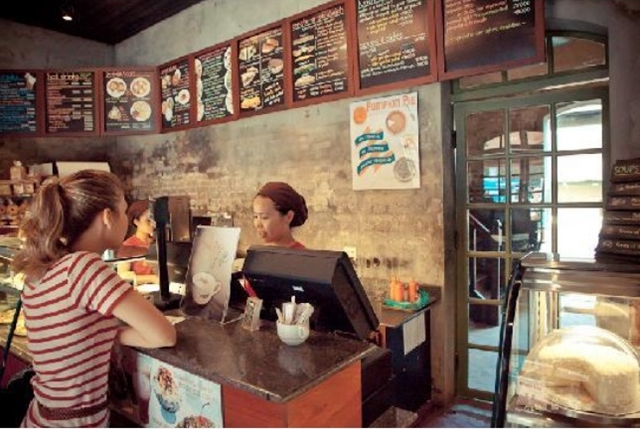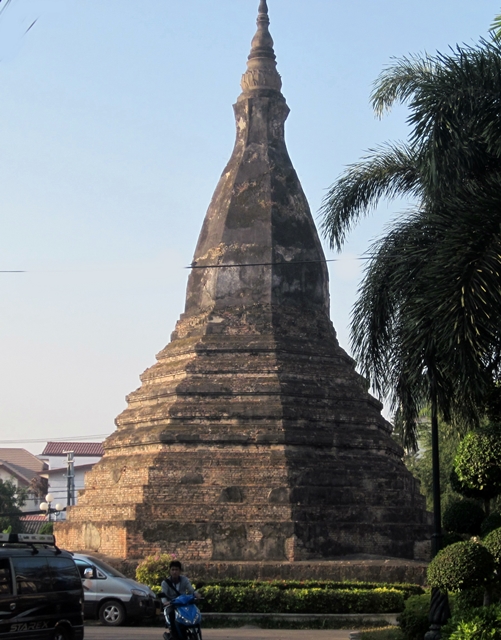Southeast Asia with Peter – Day 7
We packed up our things, ate breakfast on the veranda, and said good bye to the Grand Hotel. It was indeed a grand place to stay for a few days!

 We headed in our Tuk Tuks for the Laotian National Palace in down town Luang Prabang. At the gate we saw these little cages, each containing 2 tiny birds, I said to myself “Uh Oh, Someones breakfast?”. It happily turned out that it was good luck to buy a cage and set the birds free. I got this shot of a young man doing this. The bird is fuzzy, but he’s flying free!!
We headed in our Tuk Tuks for the Laotian National Palace in down town Luang Prabang. At the gate we saw these little cages, each containing 2 tiny birds, I said to myself “Uh Oh, Someones breakfast?”. It happily turned out that it was good luck to buy a cage and set the birds free. I got this shot of a young man doing this. The bird is fuzzy, but he’s flying free!!
 The Royal Palace (official name “Haw Kham”, was built in 1904 during the French colonial era for King Sisavang Vong and his family. The site for the palace was chosen so that official visitors to Luang Prabang could disembark from their river voyages directly below the palace and be received there. After the death of the King, the Crown Prince and his family were the last to occupy the grounds. In 1975, the monarchy was overthrown by the communists and the Royal Family were taken to re-education camps where the Prince and his family reportedly died of malaria in 1978 (probably executed by the Khmer Rouge). The palace was then converted into a national museum.
The Royal Palace (official name “Haw Kham”, was built in 1904 during the French colonial era for King Sisavang Vong and his family. The site for the palace was chosen so that official visitors to Luang Prabang could disembark from their river voyages directly below the palace and be received there. After the death of the King, the Crown Prince and his family were the last to occupy the grounds. In 1975, the monarchy was overthrown by the communists and the Royal Family were taken to re-education camps where the Prince and his family reportedly died of malaria in 1978 (probably executed by the Khmer Rouge). The palace was then converted into a national museum.
 The 3 headed Golden Elephant above the door symbolizes the three Laotian Kingdoms. Note the “Nagas” coiling protectively around the elephant.
The 3 headed Golden Elephant above the door symbolizes the three Laotian Kingdoms. Note the “Nagas” coiling protectively around the elephant.
After a stop at the famous JOMA Bakery for a take-away sandwich and a quick trip to the bathrooms, we headed to the airport for our 1 hour flight to Vientiane the capital city of Laos.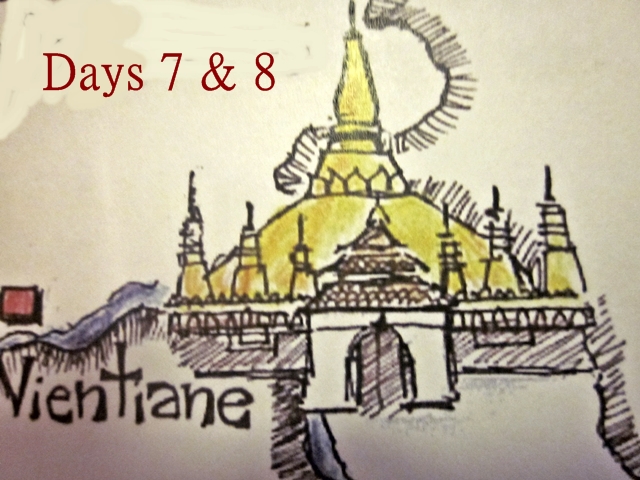
 We had an orientation walk around the center of Vientiane and ended up at the edge of the Mekong river. Dao told us a sad story of his family trying to escape from Laos in 1986. His family planned to swim to the Thailand side of the river. At the last minute his Mom said she couldn’t do it. They stayed in Laos and survived. A sad story with a happy ending!
We had an orientation walk around the center of Vientiane and ended up at the edge of the Mekong river. Dao told us a sad story of his family trying to escape from Laos in 1986. His family planned to swim to the Thailand side of the river. At the last minute his Mom said she couldn’t do it. They stayed in Laos and survived. A sad story with a happy ending!
This was during the Communist Regime. While nominally independent, the communist government was for many years effectively little more than a puppet regime run from Vietnam. The government’s policies prompted about 10 percent of the Lao population to leave the country. Laos depended heavily on Soviet aid channeled through Vietnam up until the Soviet collapse in 1991. In the 1990s the communist party gave up centralized management of the economy but still has a monopoly of political power.
The picture below is the Presidential Palace in Vientiane It pays to be President even is a one party Communist State!
 Here is the simple travelers room in the Sabaidee Hotel in Vientiane where he stayed 2 nights. Note his sneakers, backpack and red hat. He had supper in the hotel and had a nice chicken and coconut soup special.
Here is the simple travelers room in the Sabaidee Hotel in Vientiane where he stayed 2 nights. Note his sneakers, backpack and red hat. He had supper in the hotel and had a nice chicken and coconut soup special.
Southeast Asia with Peter – Day 8
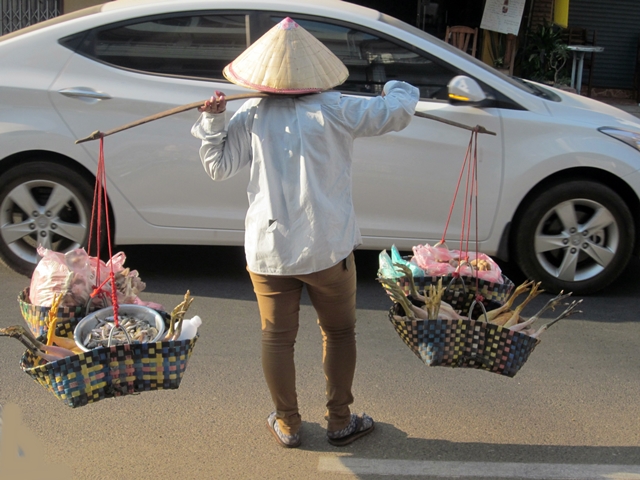
Peter and I went for an early morning walk to see if we could find the Vientiane “Morning Market’. We didn’t find it, but we saw some women carrying their own markets. These were probably 30 to 40 pound loads on a slender bamboo pole. I did buy a nice pomelo from the woman in the top picture – on the right – to lighten her load. Note the traditional hat.
We did pass the That Dam (Black Stupa). It is a large stupa located in Vientiane, the capital of Laos. Many Laotians believe it is inhabited by a seven-headed Naga who tried to protect them from an invasion by the Siamese army in 1827.

 The Golden Stupa (Pha That Luang Temple) in Vientiane is the most magnificent stupa in Laos and also one of the most recognizable. The ashes of kings of different dynasties and accomplished monks are preserved here, and it is believed to hold a relic of the Lord Buddha. It is the national symbol and pride of Laos, and a symbol of both Buddhist religion in Cambodia and sovereignty in Laos.
The Golden Stupa (Pha That Luang Temple) in Vientiane is the most magnificent stupa in Laos and also one of the most recognizable. The ashes of kings of different dynasties and accomplished monks are preserved here, and it is believed to hold a relic of the Lord Buddha. It is the national symbol and pride of Laos, and a symbol of both Buddhist religion in Cambodia and sovereignty in Laos.
The 45 meters tall golden stupa was built in 1566 when the country’s capital city was moved to Vientiane from Luang Prabang. It is the site of worship by monks and other devout Buddhists throughout the year.
That’s King Setthathirat seated in front of the Stupa. Setthathirath (1534–1572) is considered one of the great leaders in Lao history. Throughout 1560s until his death, he successfully defended his kingdom of Lan Xang against military campaigns of the Burmese. Setthathirath was a prolific builder and erected many Buddhist monuments including this Stupa.
Here’s a few shots of some of our group mugging in front of thr Golden Stupa.




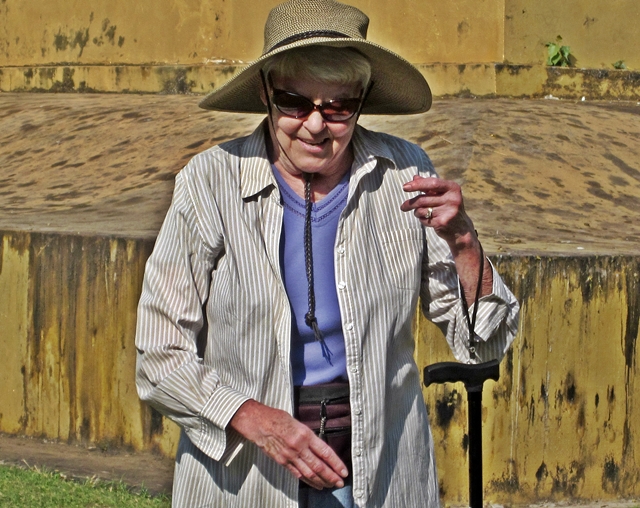 From top to bottom, they are: Joyce Spence, Gloria “OH MY GOD!” Jesaitis, Debbie Hudson, CarolGreen, and Mary Fountain. Enough mug shots!
From top to bottom, they are: Joyce Spence, Gloria “OH MY GOD!” Jesaitis, Debbie Hudson, CarolGreen, and Mary Fountain. Enough mug shots!
We left there and walked a short way to see the Reclining Buddha: That’s Janet Swartz in front of the Golden Reclining Buddha near the Golden Stupa. She’s there to give an estimate of the Buddha’s size.
That’s Janet Swartz in front of the Golden Reclining Buddha near the Golden Stupa. She’s there to give an estimate of the Buddha’s size.
In the center of Vientiane is the Patuxai. You can climb all the way up to the little window at the top to get good views of the city. Patuxai literal meaning is Victory Gate or Gate of Triumph. It is a war monument which was built between 1957 and 1968. It is dedicated to those who fought in the struggle for independence from France.

 Haw Phra Kaew is a former temple. Its interior now houses a museum and a small shop. It was built between 1565 and 1556. The temple once housed the Emerald Buddha figurine, which was brought from Chiang Mai, Thailand to Luang Prabang, Laos. When Vientiane was seized by Siam in 1778, the figurine was taken to Thonburi (a city across the Chao Phraya river from Bangkok). The revered Buddha now resides in Wat Phra Kaew, in the Grand Palace in Bangkok. We saw the Emerald Buddha on our Day 2 of this trip.
Haw Phra Kaew is a former temple. Its interior now houses a museum and a small shop. It was built between 1565 and 1556. The temple once housed the Emerald Buddha figurine, which was brought from Chiang Mai, Thailand to Luang Prabang, Laos. When Vientiane was seized by Siam in 1778, the figurine was taken to Thonburi (a city across the Chao Phraya river from Bangkok). The revered Buddha now resides in Wat Phra Kaew, in the Grand Palace in Bangkok. We saw the Emerald Buddha on our Day 2 of this trip.
Today only bronze Buddhas remain.
Here is an interesting object on the grounds of the former temple: A stone “jar”. I found a postcard in the gift shop that showed “The Plain of Jars”
The Plain Of Jars is probably South East Asia’s most enigmatic tourist attraction. Situated in the remote north east of Laos are hundreds of huge neolithic stone jars scattered across several square miles. Historians are still completely baffled as to where the jars came from, how old they are and what they signify. They are, in short, jars of a deeply spooky nature.
Whatever its ancient history, the Plain Of Jars has had a turbulent recent past. Thanks to its proximity to the North Vietnamese border, this area of Laos became of key significance during the Vietnam War and so was carpet bombed by the Americans. Laos holds the dubious record of being the most bombed country in the world, despite never officially being involved in the Vietnam war at all. The legacy of the war is still being felt, with farmers and their families regularly being killed or injured by the unexploded ordnance which still litters the Plain. See COPE notes below. Sounds like a mess to me.
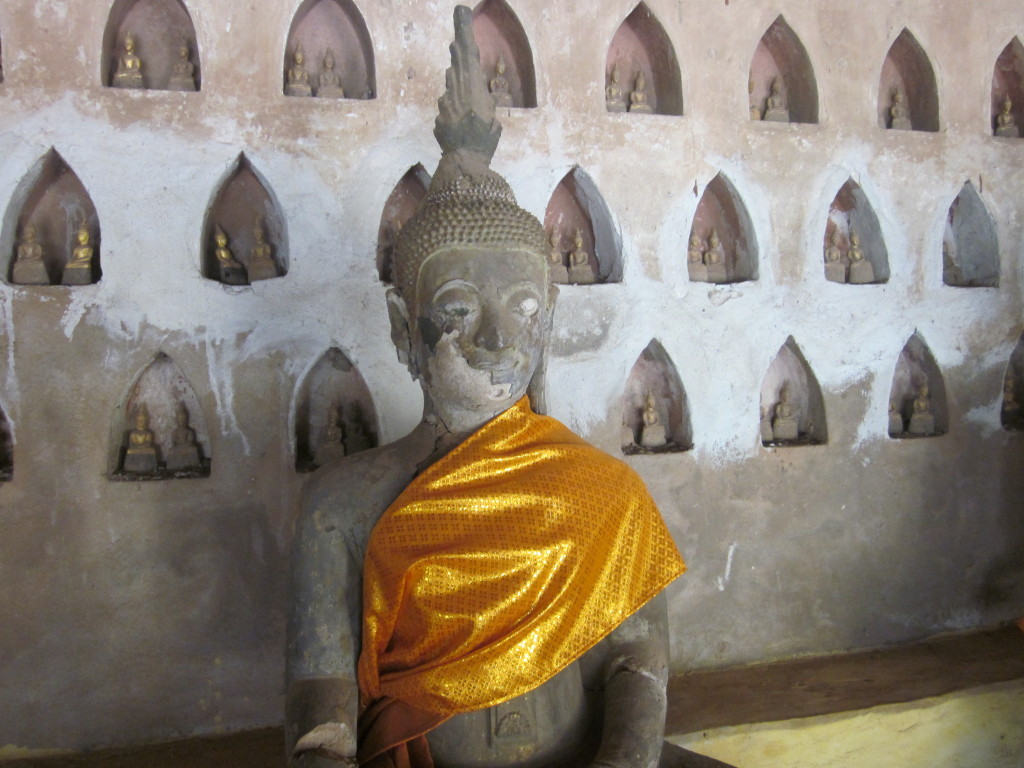 Across the street from the Haw Phra Kaew is the Wat Sisaket. This temple was built between 1819 and 1824. When the Siamese sacked Vientiane in 1828, they spared this temple, perhaps because it is built in a style similar to Thai temples. The French restored the temple in 1924, and again around 1930.
Across the street from the Haw Phra Kaew is the Wat Sisaket. This temple was built between 1819 and 1824. When the Siamese sacked Vientiane in 1828, they spared this temple, perhaps because it is built in a style similar to Thai temples. The French restored the temple in 1924, and again around 1930.
An unusual feature of the temple is the thousands of small niches in the outer wall, each of which houses a small Buddha image. On shelves in front of the wall are three rows of larger Buddha images, in various styles and materials. Many large Buddhas had their heads cracked open, supposedly to look for jewels that were put in them for consecration.
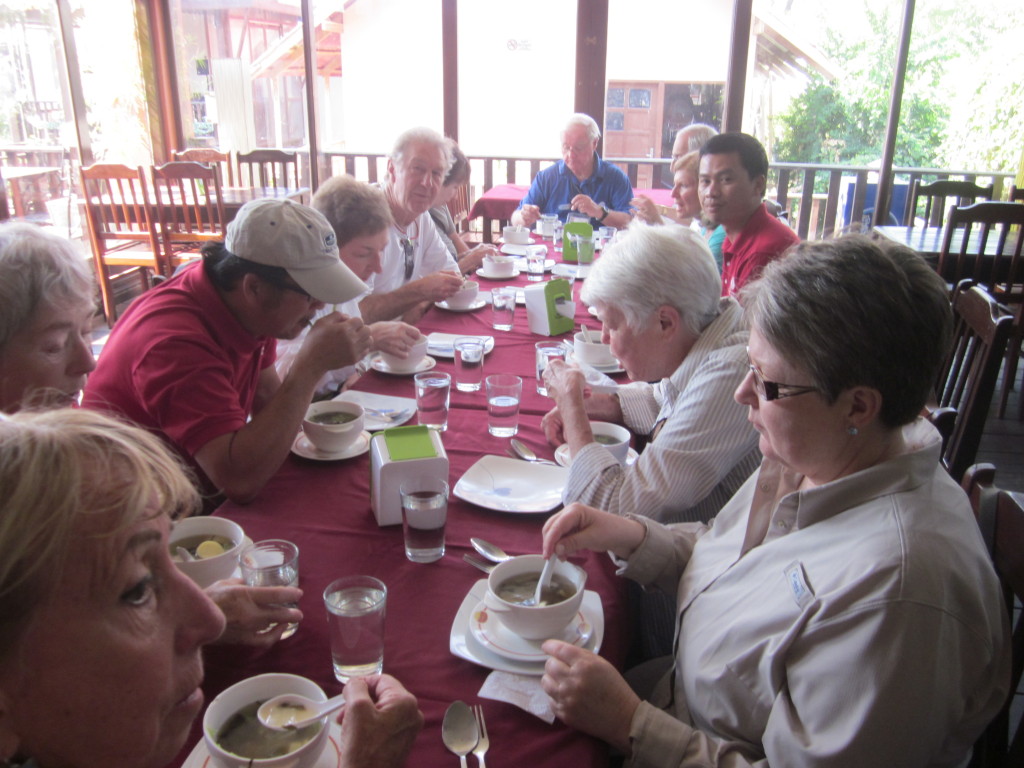 After another tasty lunch we went to a place that would have killed our appetites. The Cooperative Orthotic and Prosthetic Enterprise (COPE).
After another tasty lunch we went to a place that would have killed our appetites. The Cooperative Orthotic and Prosthetic Enterprise (COPE). Cluster bombs
Cluster bombs
The below is info from COPE literature:
COPE, is a locally run non-profit organization working with the Center of Medical Rehabilitation (CMR), Lao Ministry of Health and four provincial rehabilitation centers in an innovative partnership to provide comprehensive rehabilitation services for Unexploded Ordnance (UXO) survivors and other people with disabilities across Lao PDR.
Laos was the unfortunate side victim of the Vietnam War- the United States dropped millions of cluster and other bombs throughout southern and eastern Laos during the war. Their intention in bombing Laos is debated, but most agree that the US was afraid the small country would fall to communism if Vietnam did, as per the “domino theory.” Here’s a staggering fact: the United States dropped more bombs on Laos during the Vietnam War than all the Allies combined did during the Second World War.
Even more unfortunate for the people of Laos is that this problem persists, even decades past the war. Not all of the cluster bombs exploded on spot, so thousands of unexploded bombs (aka UXOs) remain throughout the country. So if you have the unlucky fortune to step on or somehow move a UXO, it’s likely it will explode, catching you off guard and maybe leaving you with major injury.
Potential profit adds another dimension to the issue: as scrap metal is very valuable in poor, rural towns in Laos, villagers sometimes move the UXOs on purpose in order to collect and sell them for money. The bombs are a tempting way to make easy money, and thus UXOs are not always properly disposed of. While organizations like COPE attempt to educate the citizens of Laos on the danger of UXOs, their warnings sometimes go unheard.
 A print on a tee shirt in the gift shop. ‘Nuff said?
A print on a tee shirt in the gift shop. ‘Nuff said?
 After that uplifting experience, Pete and I wandered down to the park near the Mekong. When we were there with the group on the previous evening we were approached by a young lady offering pedicures. We said “We’ll be back!” and we were. I had fingers and toes done ($3.00). Pete just had fingers. They did a super job. I wish I could have the pedicure done monthly!!
After that uplifting experience, Pete and I wandered down to the park near the Mekong. When we were there with the group on the previous evening we were approached by a young lady offering pedicures. We said “We’ll be back!” and we were. I had fingers and toes done ($3.00). Pete just had fingers. They did a super job. I wish I could have the pedicure done monthly!!

 The pedicurists were ethnic Vietnamese from Hanoi. Apparently, this is a specialty trade of Vietnamese women – even in the US.
The pedicurists were ethnic Vietnamese from Hanoi. Apparently, this is a specialty trade of Vietnamese women – even in the US.
 We ended the evening in Vientiane at an Italian restaurant near this fountain. We had some great thin crust pizzas with Will, Janet, Fred (no picture yet), and Pete. After that it was back to the Sabaidee hotel to get ready for our trip to Ho Chi Minh city tomorrow.
We ended the evening in Vientiane at an Italian restaurant near this fountain. We had some great thin crust pizzas with Will, Janet, Fred (no picture yet), and Pete. After that it was back to the Sabaidee hotel to get ready for our trip to Ho Chi Minh city tomorrow.
So endedth Days 7 and 8.

